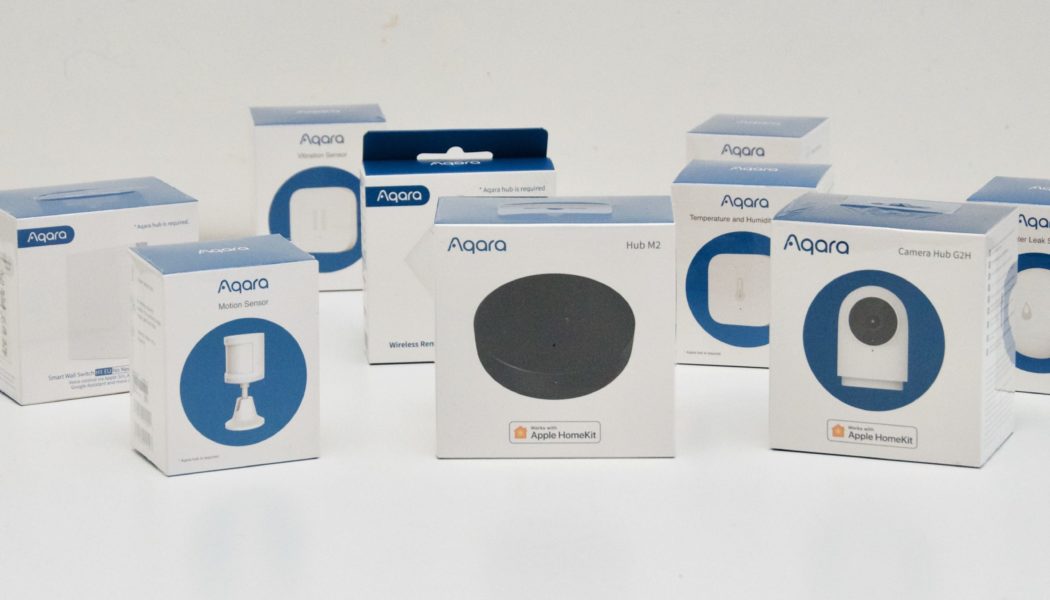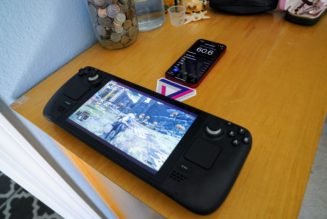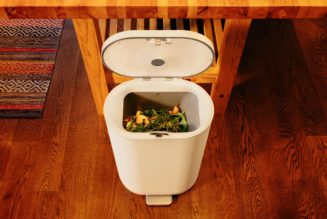The Aqara M2 smart home hub officially launches in the US today, making it the ideal time to take a deeper look at the company’s inventory of inexpensive smart home devices that work with Amazon Alexa, Google Assistant, and Apple HomeKit.
While Aqara might not have the brand cachet of Philips Hue or Samsung SmartThings, it’s been around since 2016 — an eternity for smart home companies. The Aqara brand is owned by Lumi United Technology, a Xiaomi ecosystem company based in Shenzhen, China. Aqara entered the US market in 2019 and now claims to serve over 2 million customers across 192 countries.
Aqara bills the M2 as the company’s “most advanced and future-proof smart home hub.” It connects to your home network via ethernet or 2.4GHz Wi-Fi and the Zigbee 3.0 radio controls up to 128 related devices like smart bulbs, switches, and sensors. It’ll even control infrared devices like air conditioners, fans, TVs, or humidifiers thanks to a 360-degree IR blaster that circles the hub. One day “soon,” Aqara says the M2 will also control Bluetooth LE sensors and bulbs, for example, but this wasn’t ready for me to test. The M2 is fitted with a small speaker than can be used for security alerts, a doorbell, or alarm clock. The whole thing is powered from a 5V 1A Micro-USB port, meaning the M2 hub can run for up to 30 hours when plugged into a typical 10,000mAh portable charger in the event of power failure.
I’ve been intrigued by Aqara for some time, so I decided to test the new M2 hub alongside the older M1S hub and 12 Aqara devices here in Europe where the M2 has been shipping for a while (it was announced in 2019). I also ran everything through HomeKit since the M2 takes advantage of both adaptive lighting and HomeKit secure video.
All in all, setup was quite easy and intuitive, and several of Aqara’s devices proved more capable than I expected. There were quirks, but they’re easy to overlook for the price.
My Aqara test network consisted of 16 Aqara devices spread across three floors of a narrow but tall Amsterdam home. I placed the new $57.99 / €56.99 M2 hub in my office on the top floor (third) and the older M1S hub in the living room on the ground floor (first) mainly because it has a very useful nightlight built in. The M1S is also totally self contained in a unit that plugs into any wall outlet without any cabling mess. Although my router is on the ground floor I have ethernet runs to my office, making the distance to the M2 a non-issue. With this setup, I was able to ensure top-to-bottom Zigbee 3.0 network coverage for all the Aqara child devices: six bridged to the M2 and six bridged to the M1S. The Aqara Home app makes it easy to view signal strength for each child device on a scale that ranges from poor to acceptable to good, with graphs showing how the strength changes over time.
Unfortunately, you can’t move child devices between hubs. This could be useful in cases where you move a sensor originally assigned to, say, the M1S to a room that receives a stronger signal from the M2. Instead, you have to remove the sensor from the original hub and add it back to the new hub. Fortunately, the process isn’t destructive as it maintains any automations already created in the Aqara app.
Here’s a list of all the Aqara devices I tested alongside Aqara’s recommended retail prices in USD and Euros where available:
My test network is fairly representative of the Aqara ecosystem, which varies in availability by region. Generally speaking, the US has the least amount of choice compared to Europe where Aqara also ships lightbulbs, a greater variety of wired and wireless dimmers and switches, a smart door lock, and even a controller for window shades. China has far greater choice still, much of which will likely eventually trickle out to the other Aqara regions.
So, let’s briefly dig into each of these Aqara child devices.
:no_upscale()/cdn.vox-cdn.com/uploads/chorus_asset/file/22644693/verge_DSC_4403_2040pxl.jpg)
Camera hub G2H
As the name implies, the G2H camera has the unique ability to also act as a hub for Aqara child devices. This can be useful for smart home newbies who aren’t ready to fully commit to Aqara but would still like an indoor camera that’s compatible with Apple’s excellent HomeKit Secure Video service. For example, you could drop the G2H into your home network and pair an Aqara Vibration Sensor to it that would tell the camera to start recording if a window was broken or forced open, without ever having to install an Aqara M1S or M2 hub. The G2H can connect up to 64 Aqara child devices.
The G2H camera also features two-way audio, ultra-wide 140-degree coverage, 1080p resolution, infrared night vision, definable activity zones, and a magnetic mount for easy placement on tables, walls, or the ceiling.
The G2H can record video in three ways: to the Aqara cloud, to a local microSD card (up to 32GB), or to your iCloud drive with HomeKit Secure Video enabled. I disabled the Aqara cloud recording features in favor of both microSD and HomeKit Secure Video (requires a compatible iCloud subscription of 200GB or more). Recordings to microSD benefit from an event timeline. In my home for example, I can scroll the timeline quickly by looking at the colored bars that signal the front and back doors opening, or the booze cabinet opening (I have teens). HomeKit Secure Video allows me to confidently flip on AI face recognition linked to my iCloud library so that I receive notifications when family members come home. HomeKit Secure Video also stores videos for up to 10 days without affecting my storage quota.
Aqara homes can be configured in one of six predefined regions: China Mainland, Europe, United States, South Korea, Russia, and Other. When selecting Europe, like I did, I’m protected by European GDPR law as explained in Aqara’s EU privacy policy. Aqara has its own privacy policy for the United States, which you should read if you’re concerned how this Chinese company might handle your data.
Overall, I really like the G2H as a do-it-all camera for the home, especially for the price.
:no_upscale()/cdn.vox-cdn.com/uploads/chorus_asset/file/22644688/verge_DSC_4457_2040pxl.jpg)
Wired and wireless switches and smart outlet
I tested two Aqara switches: the Smart Wall Switch H1 EU (single rocker, no neutral) and the double rocker Wireless Remote Switch.
:no_upscale()/cdn.vox-cdn.com/uploads/chorus_asset/file/22644685/verge_IMG_7921_2040pxl.jpg)
:no_upscale()/cdn.vox-cdn.com/uploads/chorus_asset/file/22644686/verge_IMG_7923_2040pxl.jpg)
The H1 wall switch is powered from the household wiring like any other light switch but results in making standard lightbulbs smart. I installed mine in the kitchen to control four existing LED spotlights that illuminate the countertop during food preparation. In addition to enabling Google Assistant, Siri, and Alexa voice control, I was able to define an automation in the Aqara app so that the lights will automatically turn off after 30 minutes whenever anyone is making a late-night snack and forgets to turn off the spots (teens!). I like the finish of the H1 and the reassuring heavy-mechanical click it makes when pressed. Aqara also makes US versions of these switches.
Although the Wireless Remote Switch shares the same form factor and tactility of the H1, it’s an entirely different product. First, it’s battery powered and meant to control other Aqara devices like smart lightbulbs or smart plugs. By default, it’s added in what Aqara calls a “high-speed click mode” which I immediately changed to “multi-function mode” to expose the single-click, double-click, and long-press actions to HomeKit for both the left and right buttons of the double-rocker switch.
:no_upscale()/cdn.vox-cdn.com/uploads/chorus_asset/file/22644687/verge_DSC_4463_2040pxl.jpg)
In the Apple Home app, I assigned a single press of the left button to turn on the Aqara Smart Plug behind my TV (with a Govee Immersion LED light strip plugged in), my Apple TV box, and LG OLED TV; and defined a double press to turn it all back off. While the Aqara app can show the energy usage of the Smart Plug over time, it can’t expose this information to HomeKit, nor can it use the information as a trigger even in the Aqara app. Ideally, I’d just plug my TV into the Aqara Smart Plug and kick off a bunch of automations when the plug detected that the TV had just turned on or off. Alas, no.
I couldn’t test the in-wall Single Switch Module T1 from Aqara as I was sent the version that requires a neutral wire. Nevertheless, I’m happy to see Aqara making these for people who prefer to make their existing switches smart instead of their lightbulbs.
:no_upscale()/cdn.vox-cdn.com/uploads/chorus_asset/file/22644689/verge_DSC_4440_2040pxl.jpg)
Door, window, motion, vibration, temperature & humidity, and water sensors
Aqara sensors offer great value and functionality that the company claims will last for two or more years on a single coin battery.
The nondescript white Door and Window sensors are particularly notable. For just $17.99 / €16.99 each, you can attach the little sensors on all your doors and windows with double-sided tape to enable any number of smart home scenarios. I have a HomeKit automation that sends me an alert when my roof hatch is open and rain is expected in the next 15 minutes (or has already arrived). I also have them configured to send alerts when the front door or freezer door have been left open too long.
The Door and Window sensors are also useful when tied to any of the four native HomeKit alarm modes (Home, Away, Night, and Off) supported by the M2 Hub (the M1S only supports on and off). In that way, the Aqara M2 can be used to create a basic home security and self-monitoring solution without having to pay any subscription fees. However, the M2’s speaker is anemic at best, so triggered alarms won’t be heard by any neighbors and are barely audible on other floors when music is playing. Anyone needing a dependable home security solution should look elsewhere for a professionally monitored service.
:no_upscale()/cdn.vox-cdn.com/uploads/chorus_asset/file/22644690/verge_DSC_4428_2040pxl.jpg)
The $20.49 / €23.99 Aqara Motion sensors are also incredibly useful. I configured the sensor to automatically trigger a Hue bulb whenever anyone enters the laundry room. It then shuts off the light automatically after five minutes. I love the tilting mount than can be placed just about anywhere, as long as you don’t mind the double-sided tape. The tape is convenient until you have to move the sensor and potentially strip paint or paper from the wall. The motion sensor has a reasonably fast reset time of one minute and includes a light sensor in the device. While the light sensor can’t be used as a trigger in HomeKit, it can in the Aqara app. Overall, the Aqara sensor is reasonably priced compared to Ikea’s Tradfri motion sensor with slower three-minute reset, no light sensor, and $14.99 / €12.95 price.
I was dubious of the Aqara Vibration Sensor before testing it out but eventually figured out a way for it to be useful. It detects vibration, tilts, and drops in addition to being configurable for three sensitivity settings (low, medium, high). Tilt is useful on a mailbox opening, for example, assuming your Zigbee signal will reach the end of a driveway, while vibration can be useful for detecting broken windows and identifying when the washer and dryer are running. I put mine on a tilting cabinet door to alert me when someone is accessing my prized collection of brown booze (teens!!).
:no_upscale()/cdn.vox-cdn.com/uploads/chorus_asset/file/22644691/verge_DSC_4426_2040pxl.jpg)
The Aqara Temperature Sensor and Humidity and Water Leak Sensor also work as advertised. The Temp sensor, like many similar cheap sensors, is inaccurate when exposed to direct sunlight, measuring almost twice the actual air temperature at times. Otherwise, it’s useful for triggering a Smart Plug to turn on a fan, humidifier, or smart blinds. Aqara envisions its Water Leak Sensor being used to send a signal to the Aqara Smart Plug to shut off a smart water valve in the case of a water leak. I currently have my review sensor sitting in a saucer just inside my roof hatch to alert me when rain comes inside. I’m tempted to try this hack to turn it into a real-time rain sensor so I can prevent the water from accumulating in the first place.
The M2 seems to offer a slight advantage over the M1S in terms of Zigbee coverage. For example, the M2 on my third floor was able to maintain a “poor” connection to the Water Sensor when moved to the first floor, but the M1S on the first floor lost connection to the same Water Sensor when moved to the third. But if coverage is your issue, then it’s better to plop another powered Aqara device into your network (like a Wall Switch or Smart Plug) which also double as range extenders for the Zigbee mesh network.
360-degree infrared control
Although I don’t have much use for a 360-degree IR blaster, it’s neat that the M2 includes it, I guess. There are plenty of IR controllable home devices like TVs, window shades, air conditioners, and fans in the world that would benefit from being included in the smart home. Just keep in mind that it’ll require line of sight visibility to the black plastic M2 hub, which looks better in a utility closet than out on a shelf. Nevertheless, I did test the IR capabilities on a handful of devices. I was able to train the M2 to control a cheap strand of LED lightbulbs and my LG OLED TV, yet it failed with another strand of LED lights and my old remote-controlled Hunter Douglas blinds. When successful, added devices can be controlled in the Aqara app and Aqara automations but aren’t exposed to HomeKit at all.
Overall, I’ve been pleasantly surprised by the M2 hub and the Aqara ecosystem of products. They’re inexpensive like Ikea’s Zigbee-based Home Smart lineup, which also works with HomeKit, Google Assistant, and Alexa. But Aqara devices are much easier to set up and frequently offer more features and better build quality.
The M2 is mostly an improvement over previous Aqara hubs with support for Zigbee 3.0 (and more child devices), reliable ethernet, HomeKit’s nuanced security modes, and IR control for those who really need it. But it also lacks the clever nightlight, louder speaker, and minimalistic design I enjoyed with the old M1S hub. Aqara also wouldn’t commit to updating the M2 with Matter / CHIP support when asked.
So while I can’t say it’s the “most advanced and future-proof smart home hub” ever, as Aqara claims, I can confirm that building a DIY smart home around the Aqara ecosystem of feature-rich devices is relatively easy, won’t break the bank, and maintains compatibility with Apple, Google, and Amazon smart homes. And really, what more can you ask for?
Photography by Thomas Ricker / The Verge










